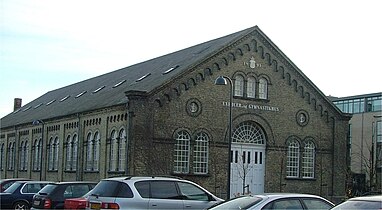Carl Thorvald Andersen
Carl Thorvald Andersen[a] (9 March 1835 – 10 September 1916)[1] was a Danish carpenter, who became the structural engineer and architect at the Holmen Naval Base in the second part of the 19th century. In this position, he designed a number of buildings for the use of the Royal Danish Navy in line with the accelerating technological development of the day. Today, these buildings are used by, among others, the Kunstakademiets Arkitektskole and the Rhythmic Music Conservatory. Andersen was succeeded in the position of architect by Olaf Schmidth in 1899.[2]
Buildings designed[edit]
- Bådeværftet (lit. 'The Boatyard') (1865, listed building)[3][4]
- Søminevæsenets Værksteder (The Naval Workshops) on Nyholm (1878–93)[5]
- Kobbersmedjen (The Coppersmithy) on Frederiksholm (1884, after the draft by Ferdinand Meldahl, listed building)[4]
- Kedelsmedjen (The Steam Boiler Smithy) on Frederiksholm (1887–88, listed building)[6]: 150 [4][7]
- Artilleriværkstedet (The Artillery Workshop) on the Arsenal Island (1888–94, demolished)[6]: 223
- Beklædningsmagasinet (The Clothing Magazine) on Frederiksholm (1888, listed building)[6]: 220 [4]
- Arresthuset (The Jailhouse) on Nyholm (1890, listed building)[6]: 54 [4]
- Exercer- og gymnastikhuset (lit. 'The Exercise and Gymnastics House') on Frederiksholm (1890–92, listed building)[6]: 165 [4]
- Modelkammeret (lit. 'The Model Chamber') on Frederiksholm (1893, listed building)[6]: 157 [4]
Gallery[edit]
-
The Steam Boiler Smithy (1887–88)
-
The Jailhouse on Nyholm (1891)
-
The Exercise and Gymnastics House (1892)
-
The Model Chamber (1893)
See also[edit]
Notes[edit]
- ^ In sources mostly mentioned by his initials C. T. Andersen
References[edit]
- ^ "Politiets registerblade". politietsregisterblade.dk. 23 June 2018. Archived from the original on 23 June 2018. Retrieved 23 June 2018.
- ^ Kulturstyrelsen, Slots- og. "Kunstindeks Danmark & Weilbachs kunstnerleksikon". Forside (in Danish). Retrieved 23 June 2018.
- ^ "Holmens Gl. Bådeværft, København". Alt om Dansk arkitektur, Danmarks arkitektur. Danish Architecture (in Danish). Retrieved 23 June 2018.
- ^ a b c d e f g * "Fredede Bygninger Juni 2018" [Listed Buildings June 2018] (PDF) (in Danish). Danish Agency for Culture and Palaces. Archived (PDF) from the original on 3 March 2018. Retrieved 23 June 2018.
- ^ Bramsen, B. (1993). København før og nu, og aldrig: Holmen og Orlogsvaerftet. København før og nu, og aldrig: en billedkavalkade om København inden for voldene og søerne (in Danish). Fogtdal. p. 123. Retrieved 23 June 2018.
- ^ a b c d e f Rasmussen, F.A. (2009). Holmen: fra flåde til folk (in Danish). Gyldendal. ISBN 978-87-02-06843-6. Retrieved 23 June 2018.
- ^ "Tøjfirma lejer historisk bygning på Holmen". Berlingske Business (in Danish). 19 November 2007. Retrieved 23 June 2018.[permanent dead link]
External links[edit]
- "FBB – sag". www.kulturarv.dk (in Danish). Retrieved 23 June 2018.
"C. T. Andersen (1835–1916)" (in Danish). Retrieved 23 June 2018.




